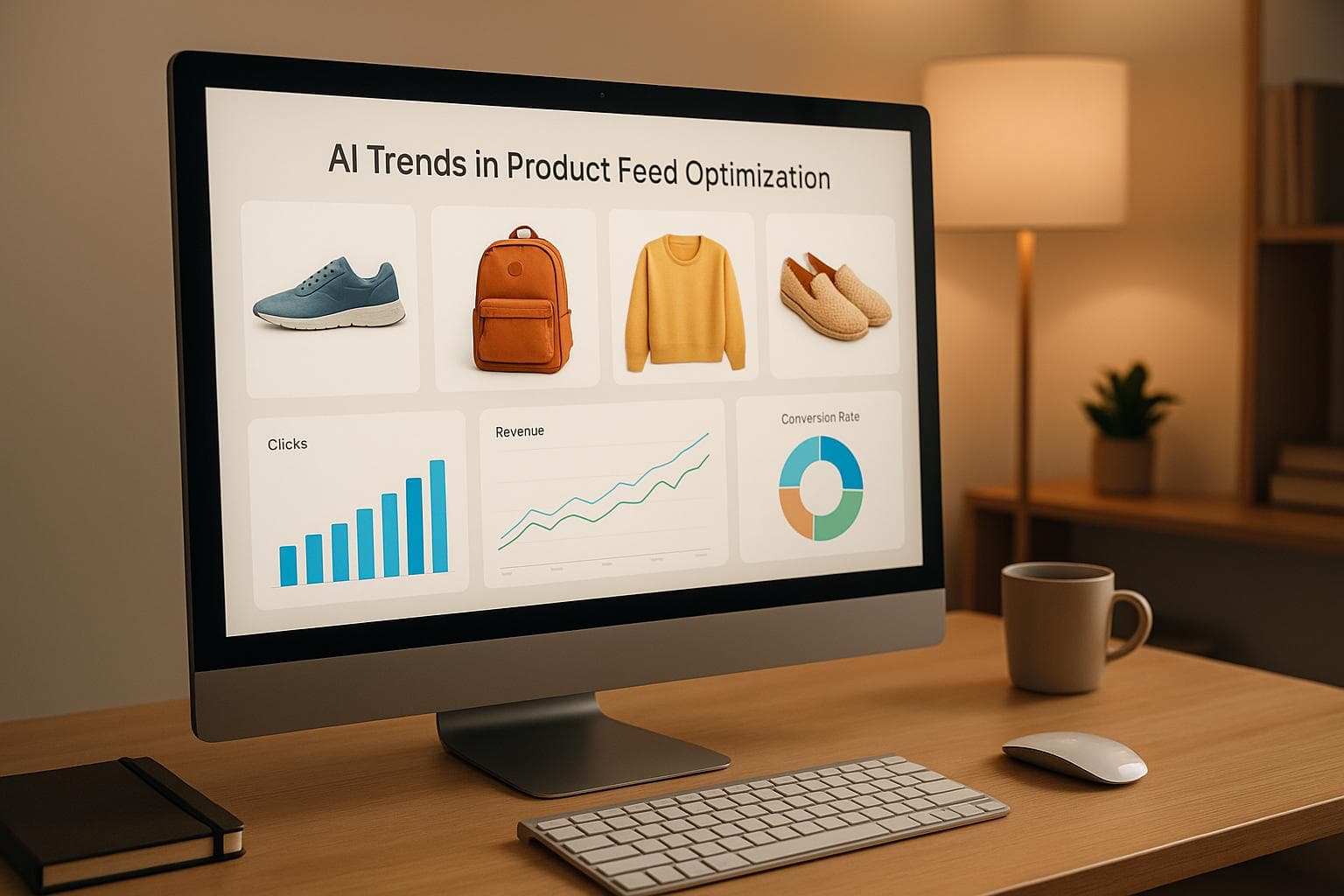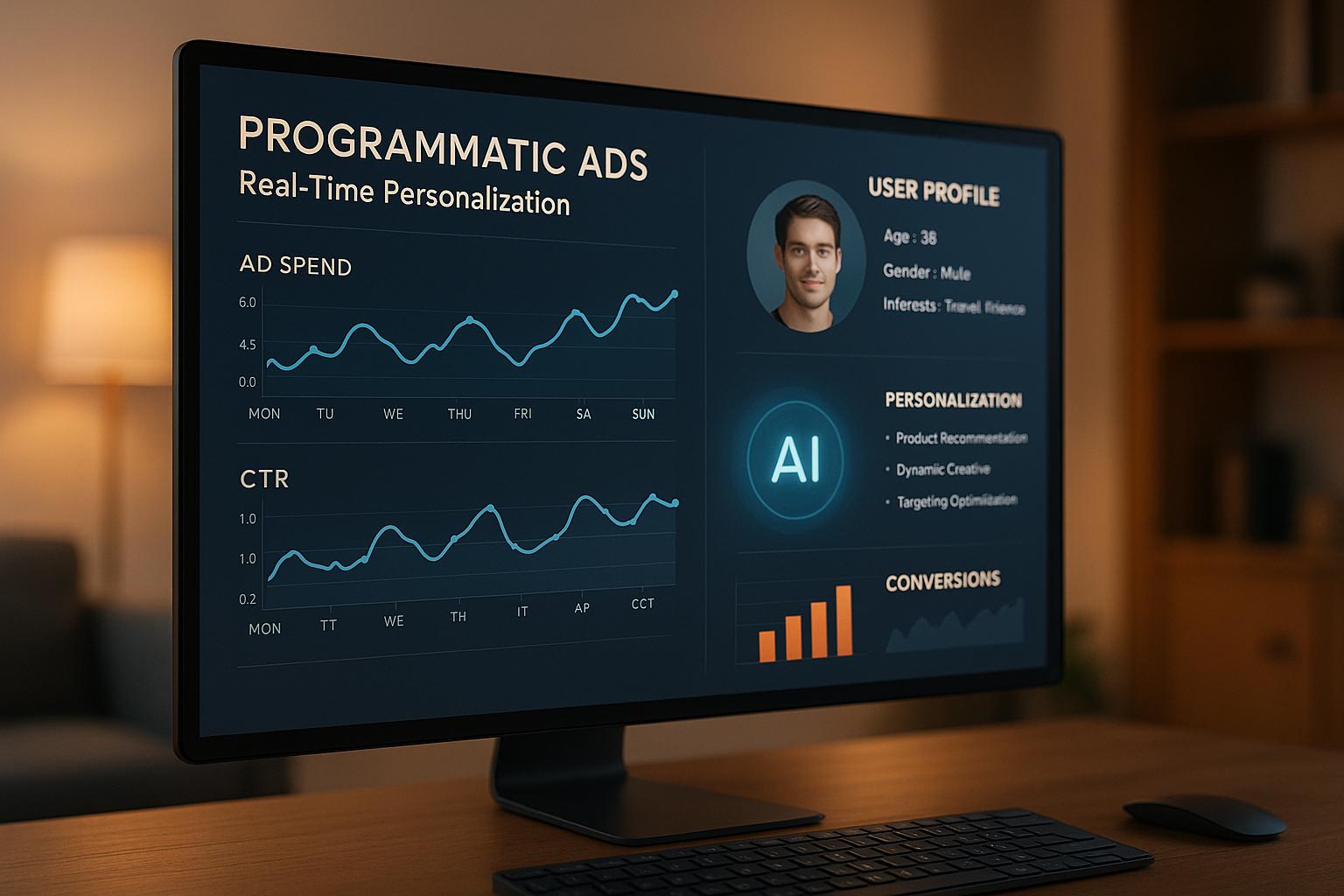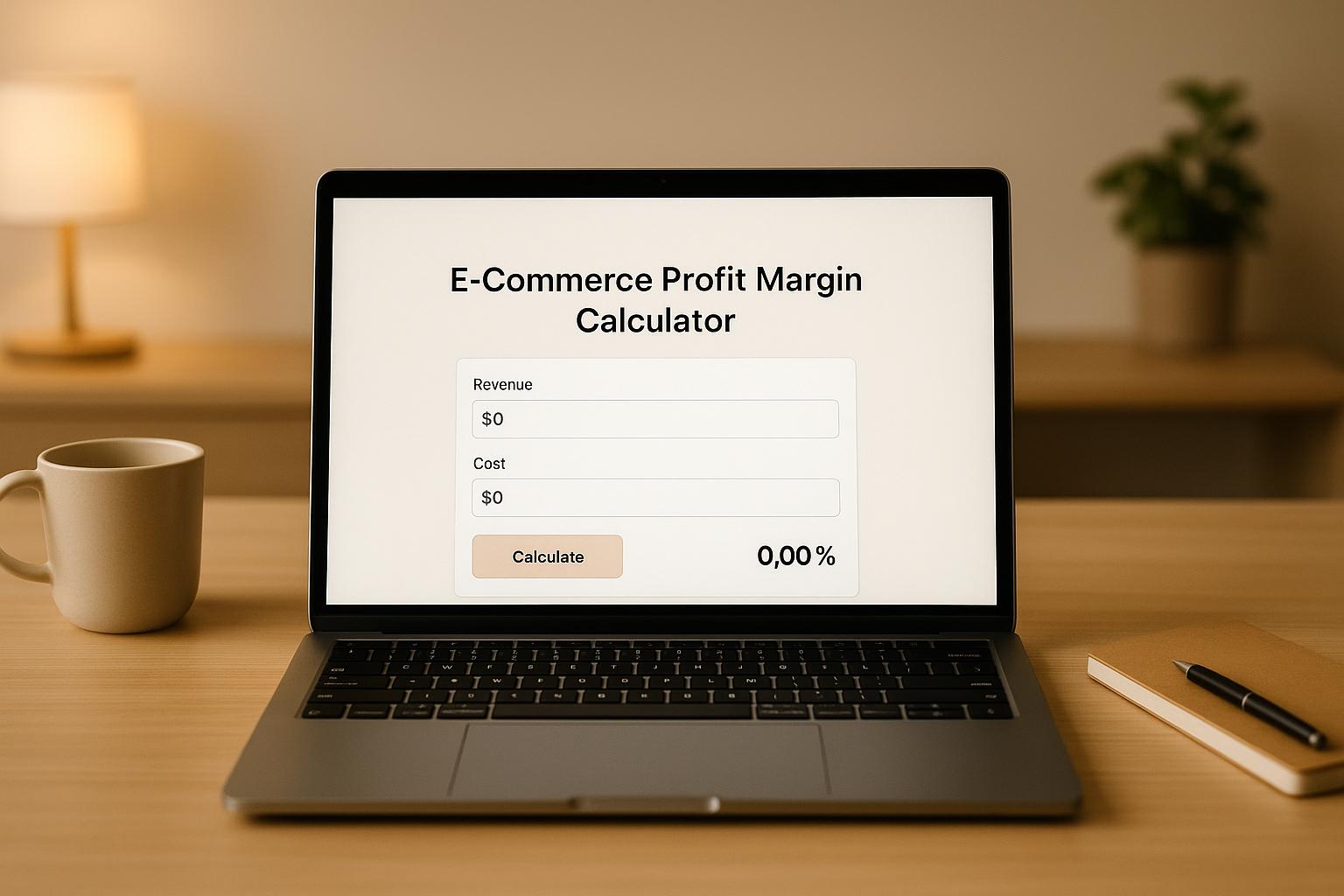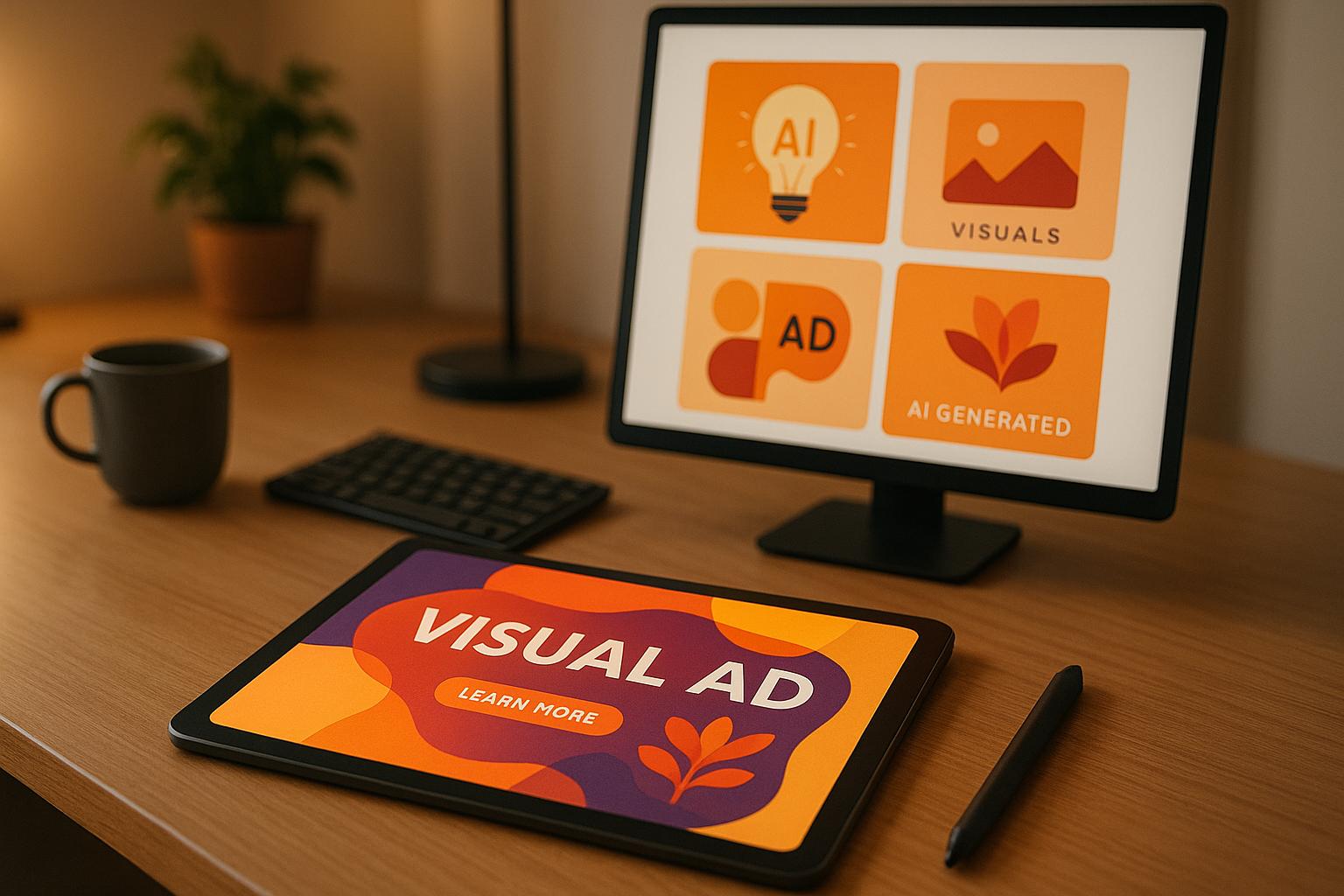AI Trends in Product Feed Optimization
AI is transforming how e-commerce businesses manage product feeds. Platforms like Feedcast.ai, FeedOps, Productsup, and SEO.AI use artificial intelligence to automate tasks such as refining product data, improving visuals, and analyzing performance. This saves time, reduces errors, and boosts ad efficiency across platforms like Google Shopping and Facebook Marketplace.
Here's a quick summary of each platform:
- Feedcast.ai: Simplifies multi-channel management, automates product data refinement, and provides cost advantages for Google Shopping campaigns.
- FeedOps: Focuses on streamlining data enrichment and improving targeting accuracy for large-scale retailers.
- Productsup: Specializes in creating visually appealing product images and videos to increase ad performance.
- SEO.AI: Concentrates on optimizing product content to improve search visibility, with less focus on visuals.
AI-powered tools have become essential for staying competitive in e-commerce. They allow businesses to refine product feeds quickly, integrate rich media, and improve ad performance across multiple channels.
Google Shopping Feed Optimization with AI | Product Feed Optimization Step-by-Step Guide
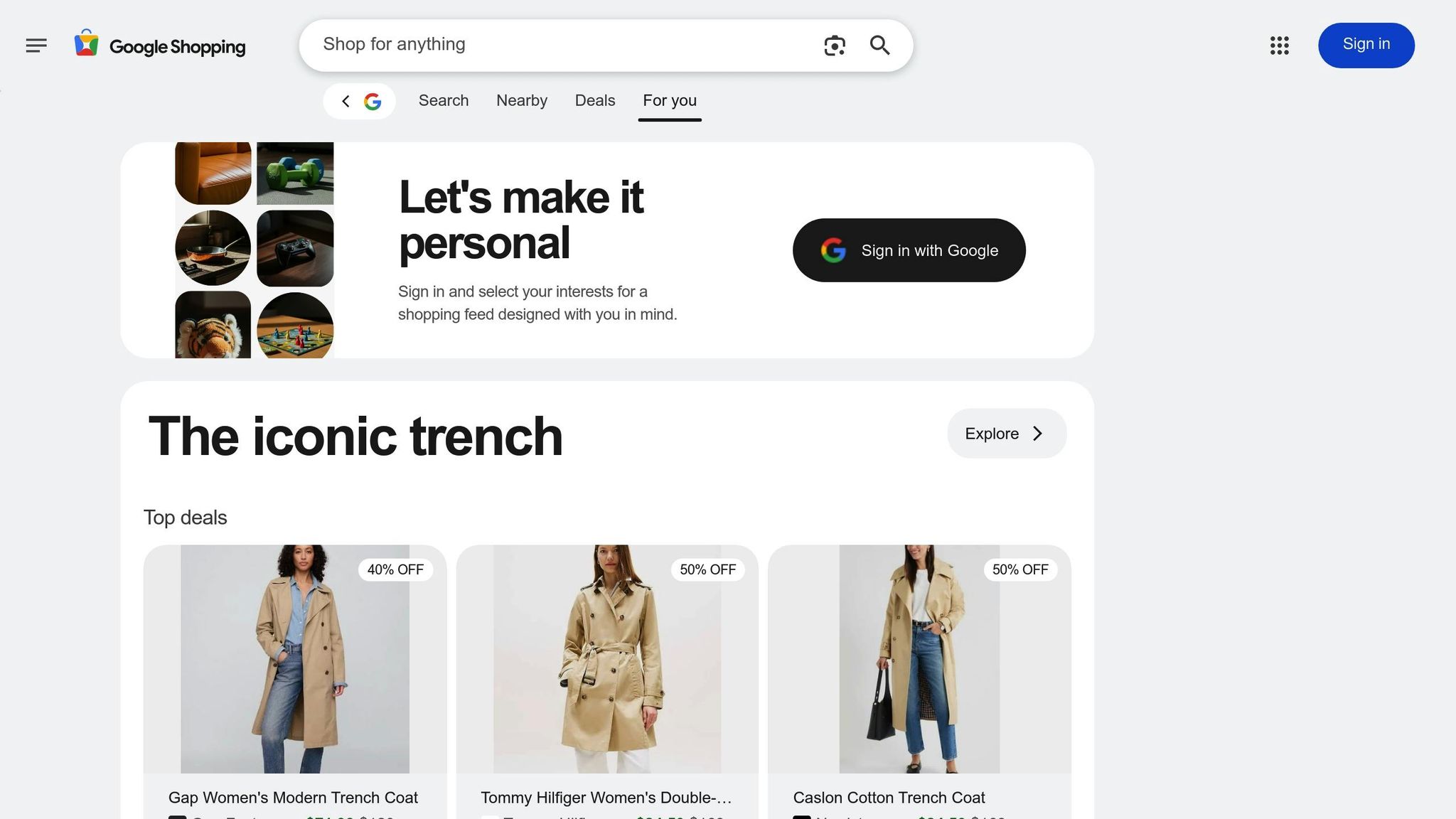
1. Feedcast.ai
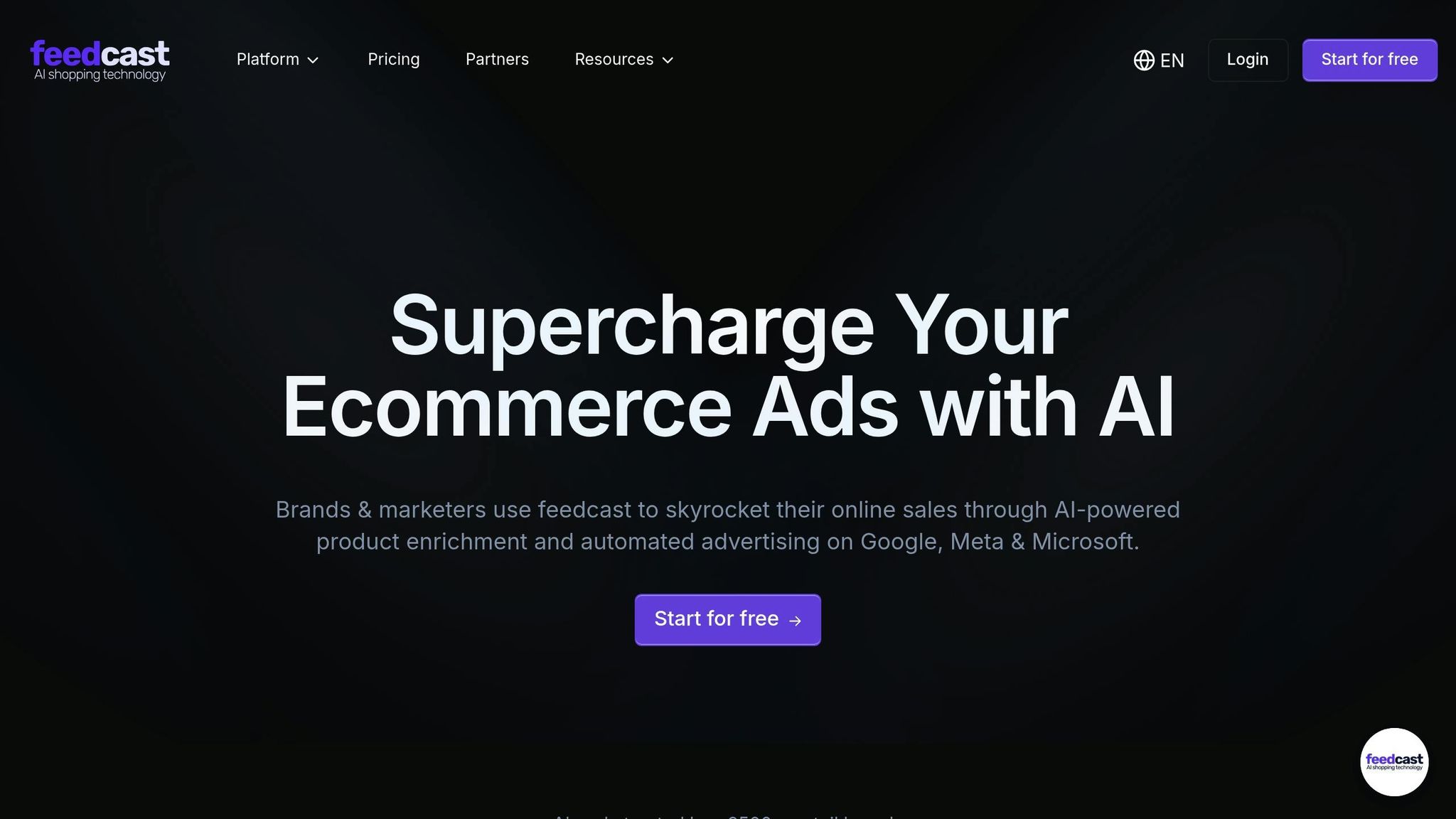
Feedcast.ai redefines how e-commerce businesses manage product feeds by automating processes like broadcasting, clicks, and sales - all in one streamlined platform [1].
Data Enrichment
Feedcast.ai uses artificial intelligence to fine-tune product titles, descriptions, and attributes without the need for manual updates [1]. The AI evaluates product data and offers tailored suggestions to meet the unique requirements and best practices of each sales channel.
Depending on their subscription plan, users receive varying amounts of AI credits, ranging from 500 credits in the Autopilot plan to unlimited credits (with a fair-use policy) in the Premium plan [1]. This flexibility allows businesses to scale their optimizations based on the size of their product catalog and their specific needs.
Multi-Channel Support
The platform simplifies multi-channel management by integrating major platforms like Google, Facebook, Instagram, Microsoft Ads, and soon TikTok, all within a single dashboard [1].
It also enables free channel broadcasting, such as Google Shopping free listings, through its CSS comparator at feedcast.shopping [1]. As a certified Google CSS partner, Feedcast.ai offers potential cost advantages for Google Shopping campaigns, making it an attractive option for businesses looking to maximize their ad budgets.
Performance Analytics
With real-time analytics, custom reporting, and segmented data, users can easily identify top-performing products and areas needing improvement. These insights enable smarter, data-driven decisions [1].
Feedback from users highlights the platform’s ease of use and quick setup for campaigns. Many have noted improvements in their results and a strong return on investment. Some even describe it as transformative for their business operations [1].
These features make Feedcast.ai a standout option when compared to other FeedOps solutions.
2. FeedOps
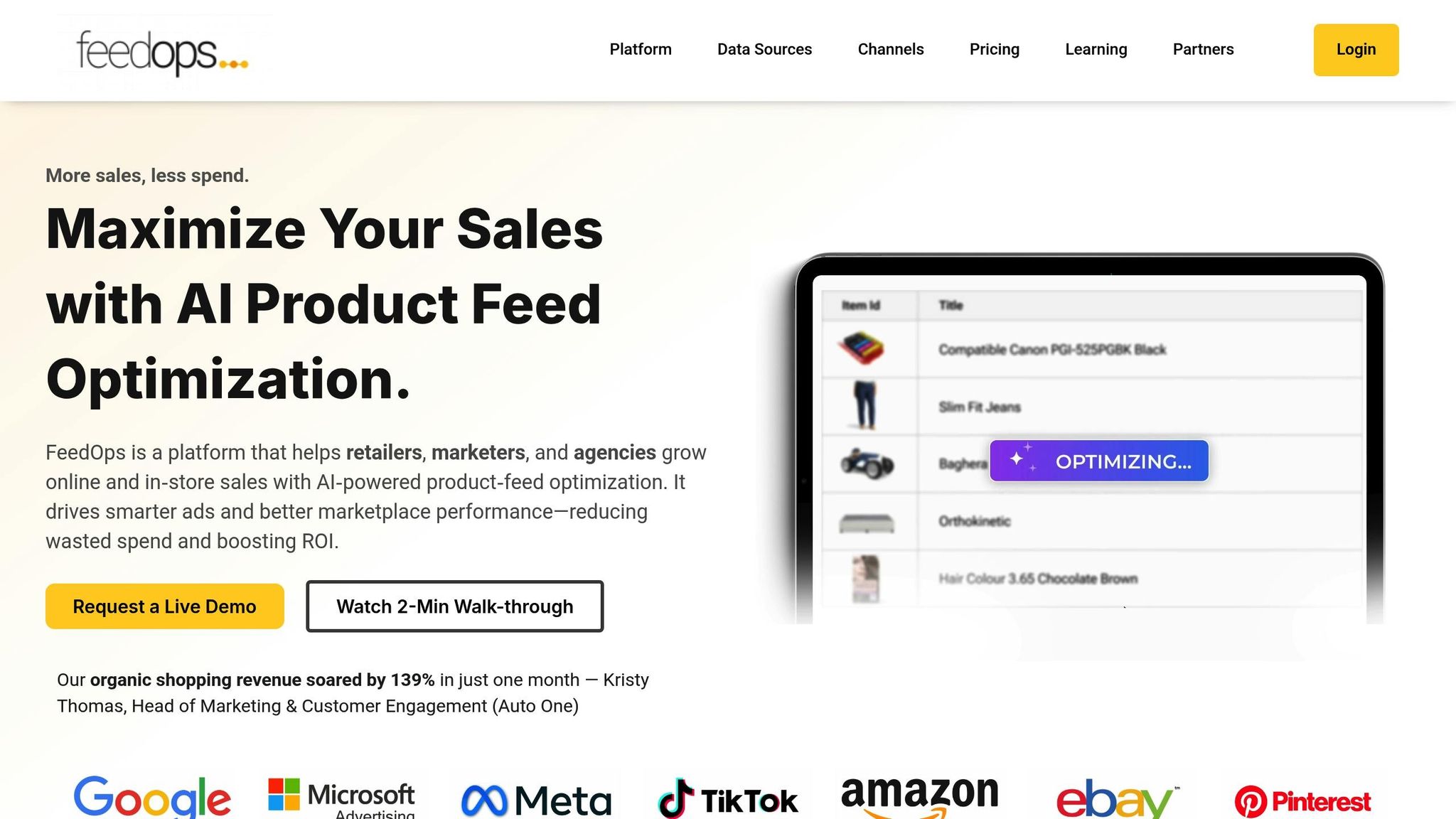
While Feedcast.ai shines in managing campaigns under one roof, FeedOps takes a different approach by focusing on automating complex tasks like data enrichment and visual optimization. Through the power of artificial intelligence, it refines product data and enhances campaign outcomes across multiple platforms, all while cutting down on tedious manual work.
Data Enrichment
FeedOps uses AI to enrich product data by extracting details like color, material, size, and gender. It also tests title variations that include high-intent, seasonal, and long-tail keywords. This process not only improves the quality of product feeds but also sharpens targeting accuracy. The result? Over 80% less time spent on manual data entry and impressive performance boosts, including up to a 700% increase in customer acquisition and a 49x return on investment [2][3][4][5]. By automating these enhancements, FeedOps lays a strong foundation for better visual and multi-channel optimizations.
Visual Media Integration
When it comes to images, FeedOps doesn’t miss a beat. Its AI tools automatically remove backgrounds, enhance image quality, and conduct A/B testing to identify which visuals drive the most clicks and conversions [2]. This ensures that your product images are optimized to perform their best across all advertising platforms.
Multi-Channel Support
FeedOps simplifies multi-channel advertising by automating product-category mapping for platforms like Google Shopping and Meta. It ensures feeds comply with platform requirements, reducing errors and preventing campaign disapprovals [2]. The AI also checks that all necessary attributes meet platform guidelines, keeping your feeds in line and ready for action. This level of precision ensures smooth performance tracking and sets the stage for accurate analytics.
Performance Analytics
FeedOps doesn’t stop at optimization - it provides real-time insights into product performance. By analyzing sales data, it identifies which products are excelling and which need a boost. These insights help businesses refine their marketing strategies and allocate resources effectively, making smarter decisions about inventory and ad spend [5].
3. Productsup
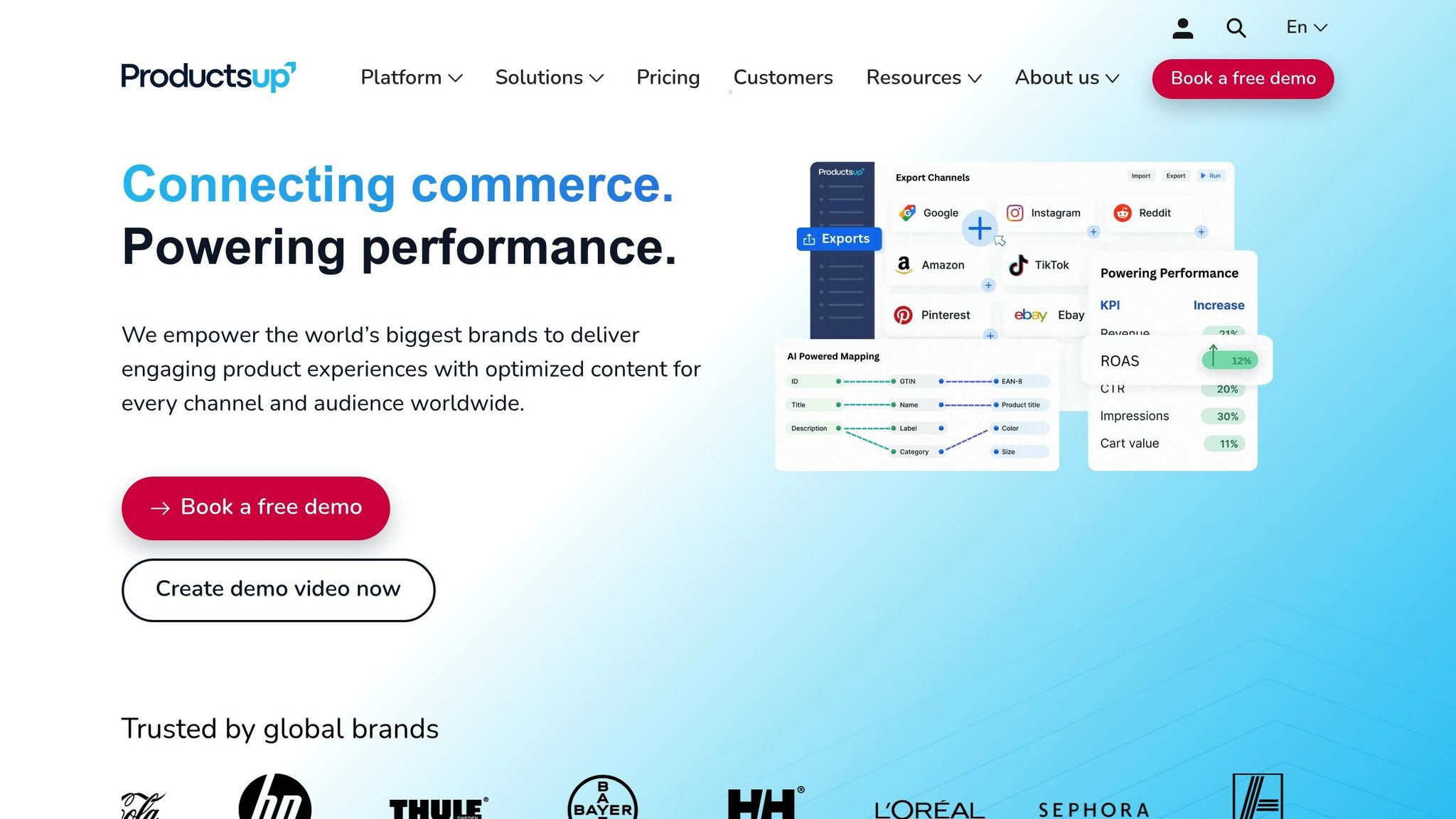
Productsup takes visual optimization to the next level by emphasizing the role of creative content in driving ad performance. This platform has carved out a niche in the product feed optimization space by making visual creativity the cornerstone of its AI-powered tools. By focusing on visually appealing content, it helps businesses turn product listings into conversion magnets.
Visual Media Integration
At the core of Productsup's visual strategy is its Image Designer tool. This AI-powered feature allows businesses to create eye-catching, conversion-oriented product images without relying on IT teams or professional designers. With access to dynamic templates, 800 fonts, and 200 icons, users can craft visuals that stand out [6].
The tool goes beyond basic image editing. It embeds essential purchase details - like prices, sizes, ratings, and logos - directly into product images. This transforms static visuals into dynamic, persuasive assets designed to grab attention and drive clicks [6]. Additionally, the platform supports immersive video ads, enabling businesses to produce engaging content that performs well across multiple advertising platforms [7].
Data Enrichment
Productsup’s Image Designer doesn’t just make visuals more attractive - it also integrates critical product information directly into the images. By embedding details such as pricing, specifications, and ratings, the platform ensures that visuals serve as both marketing tools and data-rich assets. This eliminates the need for separate text elements, making the shopping experience more seamless and engaging for potential customers.
Multi-Channel Support
The platform’s capabilities extend seamlessly across multiple advertising channels. With standardized yet customizable templates, businesses can maintain a consistent visual identity across platforms like Google Shopping, social media ads, and more. Productsup simplifies the process by allowing users to generate various content formats from a single product feed, eliminating the need for repetitive manual work. This streamlined approach ensures that visuals remain cohesive and impactful across all channels.
sbb-itb-0bd1697
4. SEO.AI
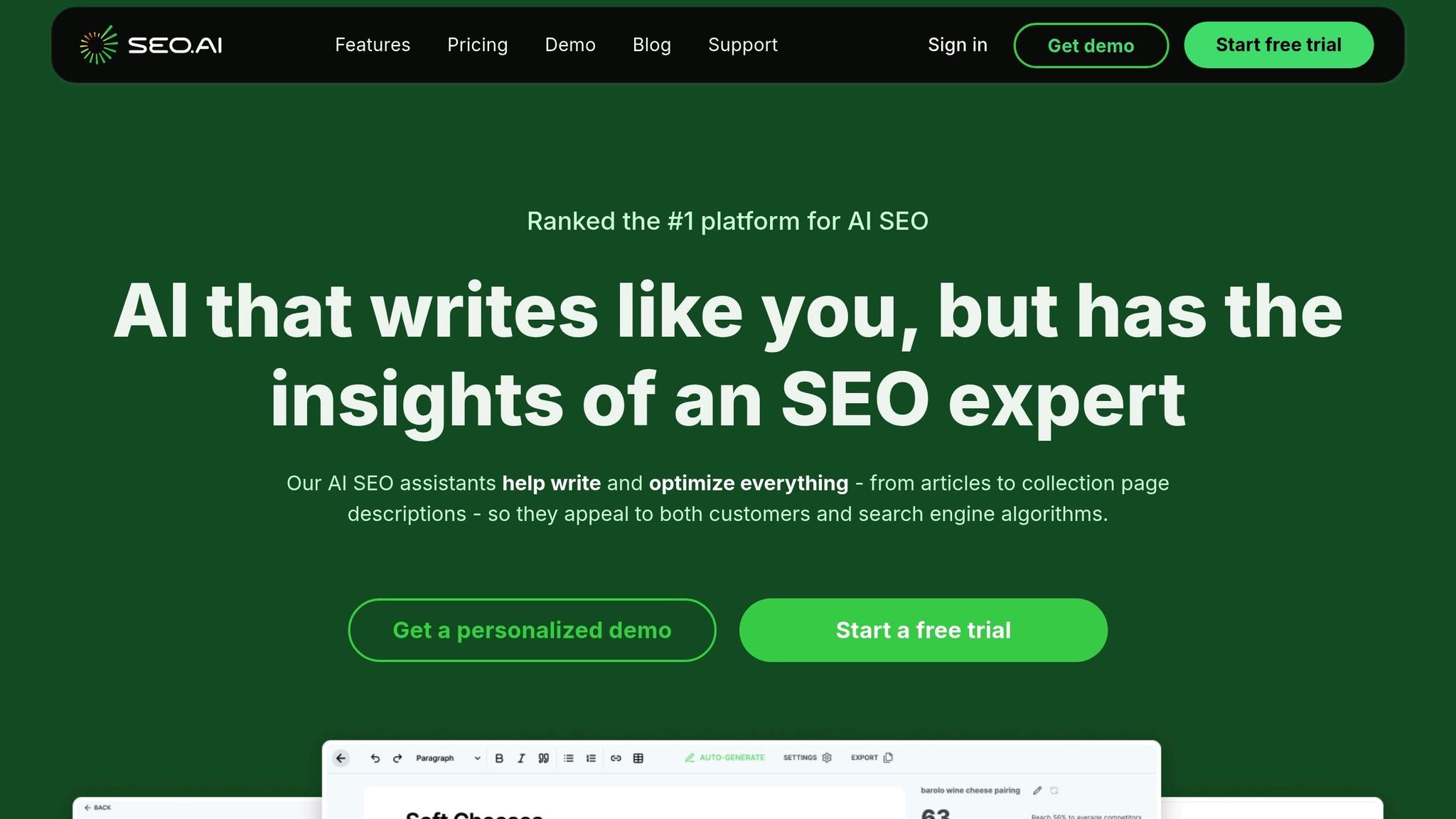
SEO.AI takes a different approach compared to platforms that prioritize visual content. Instead of focusing on visual optimization, it leans heavily on AI-driven insights to improve product content and boost search performance. However, the platform's limited documentation keeps many details under wraps, including how it enhances product listings or evaluates the impact on conversions.
From what’s known, SEO.AI uses AI to refine search performance, steering clear of the visual-first strategies commonly used by other platforms. This highlights a distinct strategy in the world of product feed management, showcasing how AI can be applied in diverse ways to optimize results.
Platform Strengths and Weaknesses
When considering AI-powered product feed optimization tools, it's essential to weigh the specific strengths and limitations of each platform. This comparison highlights how their features align with different business needs.
Feedcast.ai stands out for its multi-channel management through a unified dashboard. It’s particularly well-suited for growing businesses, thanks to its ability to handle a large volume of products and advertising channels on higher-tier plans. Its AI-powered product enrichment feature automatically refines product titles and descriptions, while its status as a Google CSS partner can help reduce costs on Google Shopping campaigns. The platform also streamlines multi-channel imports, improving efficiency. However, its free plan offers only basic functionality, with advanced features such as extra AI credits and broader multi-channel advertising available on upgraded plans.
FeedOps is tailored for automating complex product catalogs, making it a strong choice for large-scale retailers. However, its visual media capabilities are less robust compared to other platforms, which can be a drawback for businesses relying heavily on visual optimization to boost ad performance.
Productsup is designed for handling intricate data transformation and feed management. Its advanced mapping and customization tools are ideal for businesses with complex feed optimization needs. However, this level of sophistication may feel overwhelming for smaller businesses looking for a more straightforward solution. On the other hand, its strong focus on visual media integration makes it a valuable option for companies prioritizing rich media in their advertising strategies.
SEO.AI focuses on improving search performance. Its AI-driven insights are aimed at enhancing product content to boost search visibility, making it a great fit for organizations where SEO takes center stage. However, its narrower focus on search optimization means it places less emphasis on visual enhancements.
Here’s a quick breakdown of each platform’s strengths:
| Platform | Data Enrichment | Visual Media Integration | Multi-Channel Support | Performance Analytics | Best For |
|---|---|---|---|---|---|
| Feedcast.ai | Automated optimization | Standard | Unlimited channels (Premium) | Unified dashboard | Growing e-commerce businesses |
| FeedOps | Automated processing | Limited public details | Multi-platform | Operational metrics | Large-scale retailers |
| Productsup | Advanced data transformation | Enterprise-level | Extensive | Comprehensive reporting | Enterprise operations |
| SEO.AI | Search-focused optimization | Lower prioritization | Limited public details | Search performance | SEO-focused strategies |
The best platform for your business depends on factors like company size, technical requirements, and strategic goals. Feedcast.ai offers scalability and a balanced feature set, making it a great choice for businesses at various stages of growth. For enterprises with complex needs, FeedOps and Productsup provide robust solutions tailored to large-scale operations. Meanwhile, SEO.AI is ideal for organizations prioritizing search visibility above all else.
Conclusion
The landscape of product feed optimization has shifted dramatically, with AI-driven tools playing a central role in enhancing visual content and rich media integration. These advancements are directly impacting click-through rates and conversions, making them indispensable for modern e-commerce strategies.
AI-powered tools now refine product feeds by filling in missing details and transforming them into dynamic, visually compelling assets. This involves not just data optimization but also constant refinement of visual elements to keep up with consumer preferences and trends [2].
Incorporating rich media and user-generated content - like star ratings and customer testimonials - adds an extra layer of trust and appeal for shoppers. High-quality images remain a cornerstone of product visibility and conversion success, emphasizing the critical role of visual optimization [8]. Solutions like Feedcast are stepping up to meet these demands by combining automation with scalable, multi-channel capabilities.
Feedcast stands out as a robust solution for e-commerce businesses aiming to grow. With features like AI-powered product enrichment, unified multi-channel advertising management, and flexible pricing, it offers a scalable way to handle unlimited products and advertising channels. Additionally, perks like Google CSS partner advantages make it an attractive choice for businesses looking to expand their reach efficiently.
Product feeds are no longer static - they are dynamic assets that require ongoing AI-driven optimization to capture consumer attention. Businesses that integrate rich media and focus on high-quality visuals will be better equipped to thrive in today’s visually driven shopping environment.
Regular upkeep is essential to maintain these optimizations. Frequent feed health checks, for example, can help address issues like broken image links [8]. As AI technology continues to evolve, we can anticipate even more advanced features, such as automated image enhancements, background removal, and A/B testing of visual variations. By embracing these tools, e-commerce businesses can unlock superior ad performance across multiple channels.
FAQs
How does AI improve product feed optimization for e-commerce businesses?
AI is reshaping product feed optimization by taking over tasks like refining product titles, crafting better descriptions, and organizing categories to improve visibility and relevance. With advanced algorithms at work, it ensures data stays consistent, minimizes errors, and fine-tunes product details to enhance ad performance.
By intelligently reorganizing product data, AI helps create ads that are not only more engaging but also more effective. This leads to higher ROI and smoother campaign management. These tools save both time and effort, all while amplifying the impact of e-commerce advertising.
What are the main advantages of using AI-powered tools like Feedcast.ai for managing multi-channel advertising?
AI-powered platforms such as Feedcast.ai take the hassle out of managing multi-channel advertising. By automating intricate tasks and fine-tuning campaigns across major platforms like Google, Meta, and Microsoft Ads, they not only save time but also streamline the entire advertising process.
These tools bring advanced features to the table, enabling businesses to sharpen their targeting, tailor ad content to specific audiences, and refine product data. The result? Stronger customer connections and a noticeable boost in return on investment (ROI). Plus, with unified dashboards and real-time analytics, tracking performance and making smart, data-backed decisions becomes much simpler. This combination of automation and insight empowers e-commerce businesses to grow more efficiently and effectively.
How do rich media and user-generated content improve e-commerce ad performance?
Rich media, including interactive visuals and videos, makes advertisements more engaging and immersive, leading to higher customer interaction and better conversion rates. Research indicates that these types of ads are particularly effective at grabbing attention, which often translates into a noticeable boost in engagement.
User-generated content (UGC) - like customer reviews, photos, or testimonials - adds a layer of trust and relatability. Ads that incorporate UGC tend to achieve higher click-through rates and foster stronger connections with audiences, as people are more likely to trust genuine experiences shared by their peers. When combined, rich media and UGC create ads that are not only visually striking but also resonate on a personal level, driving improved performance and increased sales.
Geoffrey G.
